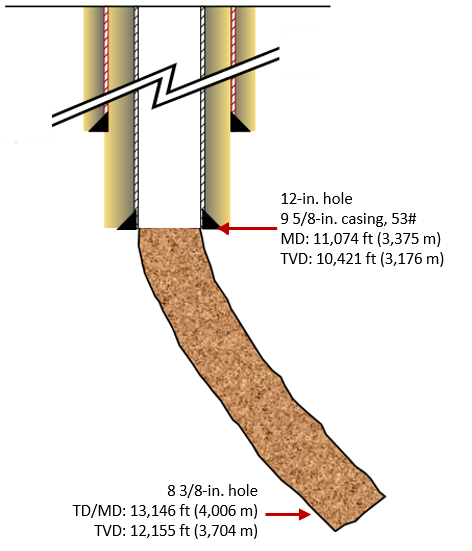Objectives
- Deploy and cement a 7-in. liner using managed pressure cementing (MPC) techniques
- Use a lighter mud weight and surface pressure to achieve the minimum overbalance and prevent the well from flowing
- Achieve successful zonal isolation by securing full returns during the cement job
Our Approach
- The well was drilled with managed pressure drilling (MPD) from the 9 5/8-in. casing shoe at a measured depth (MD) of 11,074 to 13,146 ft (3,375 to 4,006 m), with 2,072 ft (631 m) of 8 3/8-in. openhole exposed. Additionally, there were substantial variances of different pressure zones, with an upper formation pressure of 144.5 pcf equivalent—where the well would flow if gone under—and penetrating through a weaker formation with a fracture gradient of 147 to 148 pcf equivalent.
- Extensive pre-job planning and multiple simulations generated a table of the required surface backpressure (SBP) values from the choke manifold corresponding to each barrel of mud, spacer, and cement pumped while maintaining the equivalent circulating density (ECD) within the allowed window throughout the cement job. In addition, a contingency plan accounting for any cement or rig pump failure was put in place to effectively maintain the well under control with the underbalanced fluid even in the event of a pump failure.
- The Weatherford team deployed a rotating control device (RCD) and the MPD system to enable the application of MPD and MPC techniques.
- The MPC operation used a fully automated MPD choke programmed by a real-time simulation module to maintain the target ECD by adjusting the SBP automatically as a 140 pcf spacer and a 150 pcf cement slurry entered the annulus.
- When the SBP was reduced to the minimum pressure allowed without the ECD at the shoe falling below 144 pcf, the pumping rate was then reduced.
- The cement was displaced with 135 pcf mud. The maximum ECD on the bottom recorded throughout the job was 149.4 pcf, slightly above the fracture gradient of the weakest exposed formation, but no losses were encountered due to the lost circulation material in the spacer and slurry.
- Upon completion of the cement displacement, the MPD choke applied the final backpressure to maintain the bottomhole pressure constant above the pore pressure, considering the mix of different fluids in the wellbore (slurry, spacer, and underbalance mud) with the respective heights in the annulus
- The liner packer was set under static conditions, and a negative flow check was performed, successfully followed by releasing the running tool and reversing the circulation of overbalanced mud conventionally.
Value to Customer
- MPD and MPC techniques enabled the operator to drill the 8 3/8-in. hole section and run and set the 7-in. liner to the MD of 13,146 ft (4,006 m), maintaining the equivalent mud weight above 145 pcf with the SBP gradually reduced from 800 to 600 psi.
- At the bottom, the well was displaced with the MPD system from 145 to 135 pcf, controlling the pumping rate and surface pressure to achieve the target overbalance equivalent mud weight until 135 pcf mud was in and out.
- MPC techniques maintained zonal isolation integrity during the entire operation, avoiding induced losses because of potentially high ECDs during the cement displacement operations.
- The successful isolation of the high-pressure zones enabled long-term well integrity.
Learn More
Details
Location
Middle East
Measured Depth
11,074 to 13,146 ft (3,375 to 4,006 m)
Products/Services

×
![]()
Different environments present unique challenges. MPD and MPC deliver comprehensive pressure management no matter the environment, including this operation with 2,072 ft (631 m) of 8 3/8-in. openhole exposed.
×
![]()